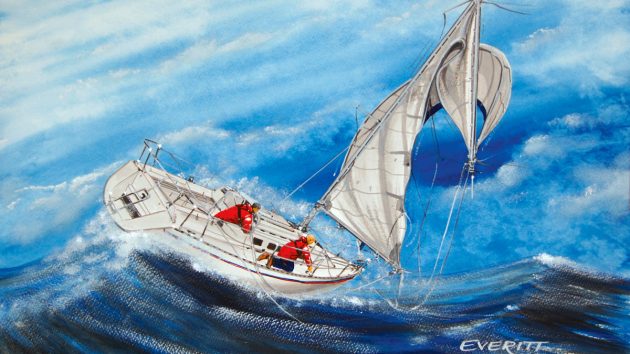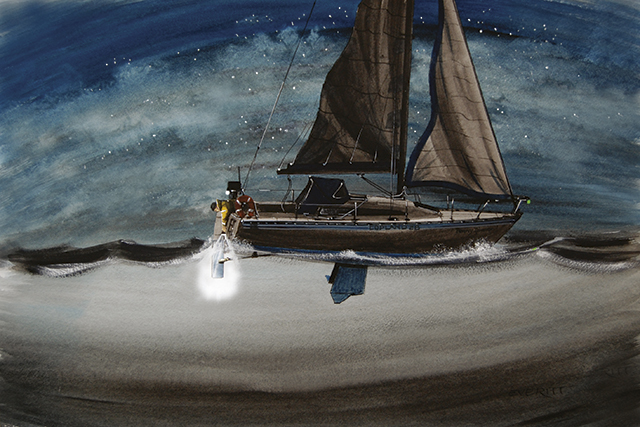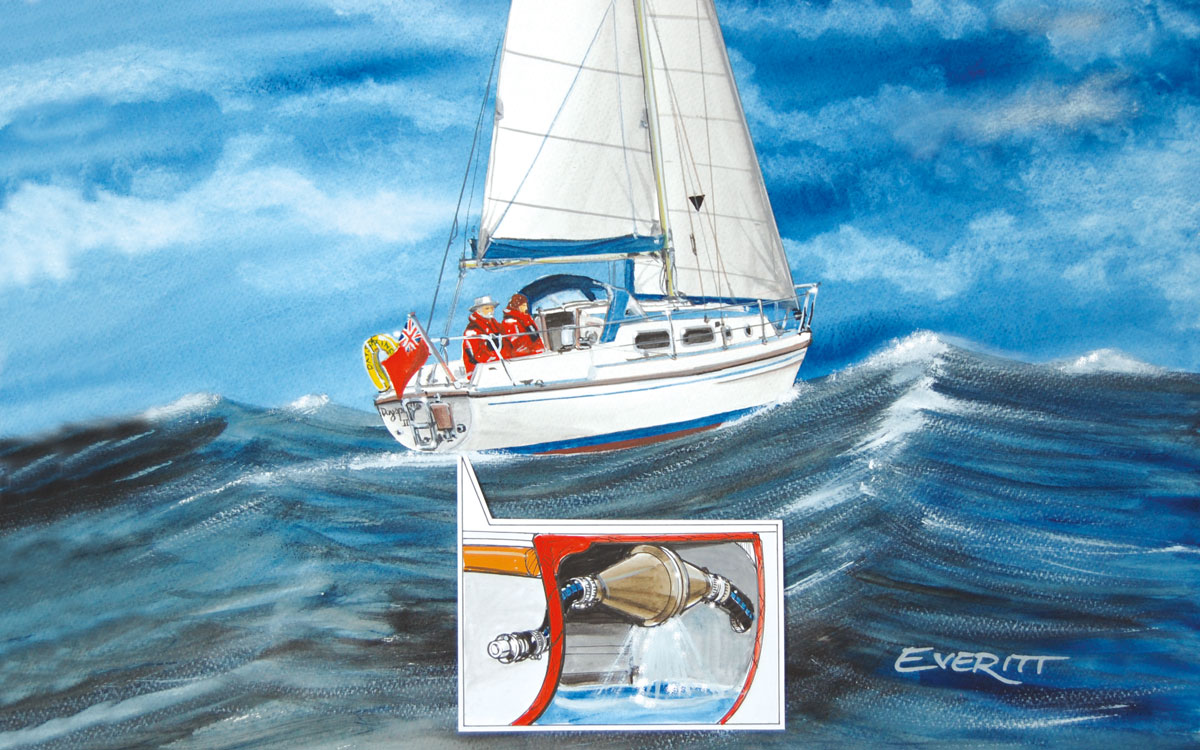Rob Crabbe recalls the rig of a new yacht breaking on a delivery trip from Dartmouth to the Southampton Boat Show
When I was at university in the mid-1990s, young and undoubtedly invincible, I used to do a few deliveries along the south coast.
My Dad had worked with a company in Totnes who imported yachts from the manufacturer in France and, using that connection, they used to get me to go and bring the part-exchange boats from where they were moored back to the yard on the Dart.
This was generally done with my friend, Jeff, who I’d met at university.
Like me, he was completely indestructible so the thought of being dropped off at some south coast port on a Friday night with some food and keys to a completely unknown boat to get back as soon as possible didn’t make him bat an eyelid.
One thing that didn’t happen often though was the chance to sail one of the new boats; as you can imagine, the new owners of most of them were keen to sail them home for the first time.
So when the opportunity to sail a brand-new 31-footer from Dartmouth to Southampton in late August for the boat show we thought…brilliant!

Rob Crabbe (right) with his university pal and sailing partner, Jeff
The boat was shiny and we expected a fast trip.
So we set off about 1800 on a Friday night – wind was south, south-westerly about Force 4, and actually stayed that way (not that we really bothered to take notice of forecasts or tidal gates or whatever).
We were doing a three-hour (ish) rotation and thoroughly enjoying ourselves.
We had a quick trip across Lyme Bay, sticking on a starboard gybe all the way, but then got stuck a bit too close inshore off Portland so hardened-up and headed out more south-easterly around 0200-ish to avoid the overfalls.
It was about 0600 and I was having a kip in the aft cabin.
We were about 10 miles south of the Needles and Jeff decided it was time to gybe and head north.
The gybe didn’t wake me but the almost instantaneous loud bang, followed a shortwhile later by a shout from Jeff:
“Rob – the mast has broken!” got me up pretty quickly.

About 10 miles south of the Needles Lighthouse, Jeff gybed and there was an instantaneous loud bang. Credit: Stuart Aspey/Alamy
Going on deck, I could see that the mast had snapped almost completely into two pieces just above the upper spreaders.
The top third of the mast was hanging down by a thread of aluminium at the break and also supported by the internal halyards.
The roller genoa was in and out of the water and the lower two thirds of the mast was still standing but, with now loose lower shrouds, was waving around all over the place.
The swell, which we hadn’t really noticed up to that point, was actually about 2m and really making the rig roll all over the place.
A quick appraisal left us pretty unsure what to do next and, for a brief moment, a little bit of panic set in.
We did have a VHF but the antenna was at the top of the mast.
We tried the handheld VHF we carried but no joy (and, with hindsight, not really sure what we would have achieved).
It soon became clear we needed the mast down – it was very not pleasant having it swing around above us.
But – we had absolutely nothing except a rigging set with a Captain Currey knife and a pair of pliers…
Nevertheless, I went forward to start to undo the bottlescrews.
I still go cold when I think of myself sitting on the side-deck, trying to undo the cap shroud, with the mast foot crunching and grinding around about two feet from me.
It took about two minutes of trying to realise this wasn’t going to work – moving back to the cockpit Jeff and I, unbelievably late, decided below was the best place to be.
Literally five seconds after closing the sliding hatch behind us the rig came down across the cockpit.
At least we could now venture outside without risk of a rig falling on us. On getting back into the cockpit we could see the rig went from the mast shoe, diagonally out to the starboard quarter and into the water.
The roller reefing went out to port and the masthead was in the water directly astern.
Luckily, there were plenty of lines still attached and we were able to drag all the components up and out of the water, basically forming a large triangle sitting on top of the boat.
Once lines were clear of the water, the engine went on and we started heading north.

Keeping others informed
Our thoughts once again turned to letting other people know we had a problem.
The VHF was still not getting a response so, using my dad’s very early (analogue) mobile phone he’d lent me to arrange him coming to pick us up in Southampton, I dialled 999.
This, amazingly, worked a treat and we were soon through to the Coastguard.
A rough position allowed them to tune their antennas in our direction and soon we had them on VHF and a schedule worked out to call them regularly on our way in.
Next on the list was to sort out what had gone wrong – with inspection we realised that the rig was unusual (in those days) in that there was only a single cap shroud from the deck to the first spreader.
At the end of the spreader was a clevis pin, held in place by a split pin, that joined the single deck cap shroud to two further shrouds – one joining the mast at the base of the second spreaders and the other going to the outboard end of the top spreader and then to the top of the mast.
We could see this was all still attached on the starboard side (which had been under tension all night as on starboard tack) but, on the port side, the clevis pin was missing.
It soon became clear, by looking at the starboard side, that the split pin holding the clevis pin in place had barely been long enough to go through and could not be opened enough to hold it in place.
The port, leeward, shrouds had been slack and vibrating enough to work the split pin, followed by the clevis pin, out meaning that when we gybed, the mast came under load with no support – bang!
This led to another call, this time to the owner of the yacht import company.
The message left on their answerphone was not repeatable and included a promise to take the boat, in its current state and with company flag flying, into the marina at the Southampton Boat Show.

Rob Crabbe was heading for the Southampton International Boat Show when the rig came down. Credit: PA Images/Alamy
However, after a very long day motoring (with a very small engine!) against the tide up the Needles channel, waving to lots of other boats coming for a look, we were persuaded to head into Lymington.
Straight alongside, met by the company owner, mast lifted off and then sleep in the car on the way home.
Amazingly, the only damage to the boat itself was a 6in scratch to the gelcoat next to the mast step.
Article continues below…
New Zealand to Fiji on a 26-footer – learning from experience
Euan Crawford experienced mixed fortunes when he and his girlfriend sailed their uninsured, un-surveyed, 30-year-old Raven 26 from New Zealand…
Trapped in a locker in a sinking yacht
As if loss of steering and starting to sink wasn’t bad enough, John Broadhead was forced to keep a cool…
Learning from experience: Chasing the leak on a sinking boat in Lyme Bay
Dr Brian Johnson became quickly and intimately acquainted with his engine’s silencer when it threatened to sink his Westerly Pageant…
LESSONS LEARNED

Early mobile phone proved a big help
- The rig set-up was what actually caused the failure. I think the design was flawed BUT that doesn’t excuse me for not checking the boat out a little more. A new boat has not been tested and really, I should have satisfied myself that it was going to hold together the first time it was sailed. It would have meant going up the mast but that would have been time well spent.
- Take tools and spare parts, including something to cut the rigging – we had nothing. Think what you may need and carry it no matter what the circumstances.
- Think about losing a mast. I had never considered it before. I almost certainly assumed it was something that, if it happened, would just come down. The half up, half down we experienced was really challenging and, in truth, there was nothing we could do but wait down below. Had the weather been worse it would have come down more quickly but could also have caused more significant damage.
- Safety gear – we were woefully unprepared. No emergency VHF antenna, no liferaft and, worse of all, 5no flares. I hang my head in shame.
- Youth – I suppose we were OK so maybe we were invincible but I think we were just lucky!
Why not subscribe today?
This feature appeared in the February 2022 edition of Practical Boat Owner. For more articles like this, including DIY, money-saving advice, great boat projects, expert tips and ways to improve your boat’s performance, take out a magazine subscription to Britain’s best-selling boating magazine.
Subscribe, or make a gift for someone else, and you’ll always save at least 30% compared to newsstand prices.
See the latest PBO subscription deals on magazinesdirect.com







